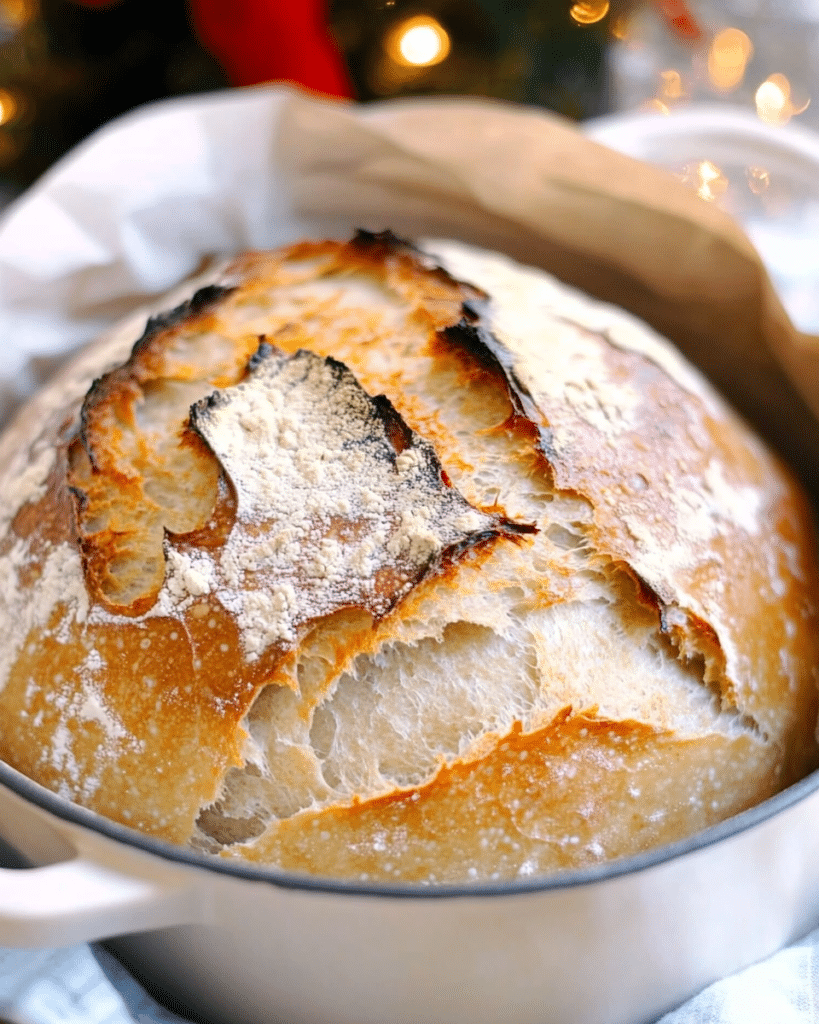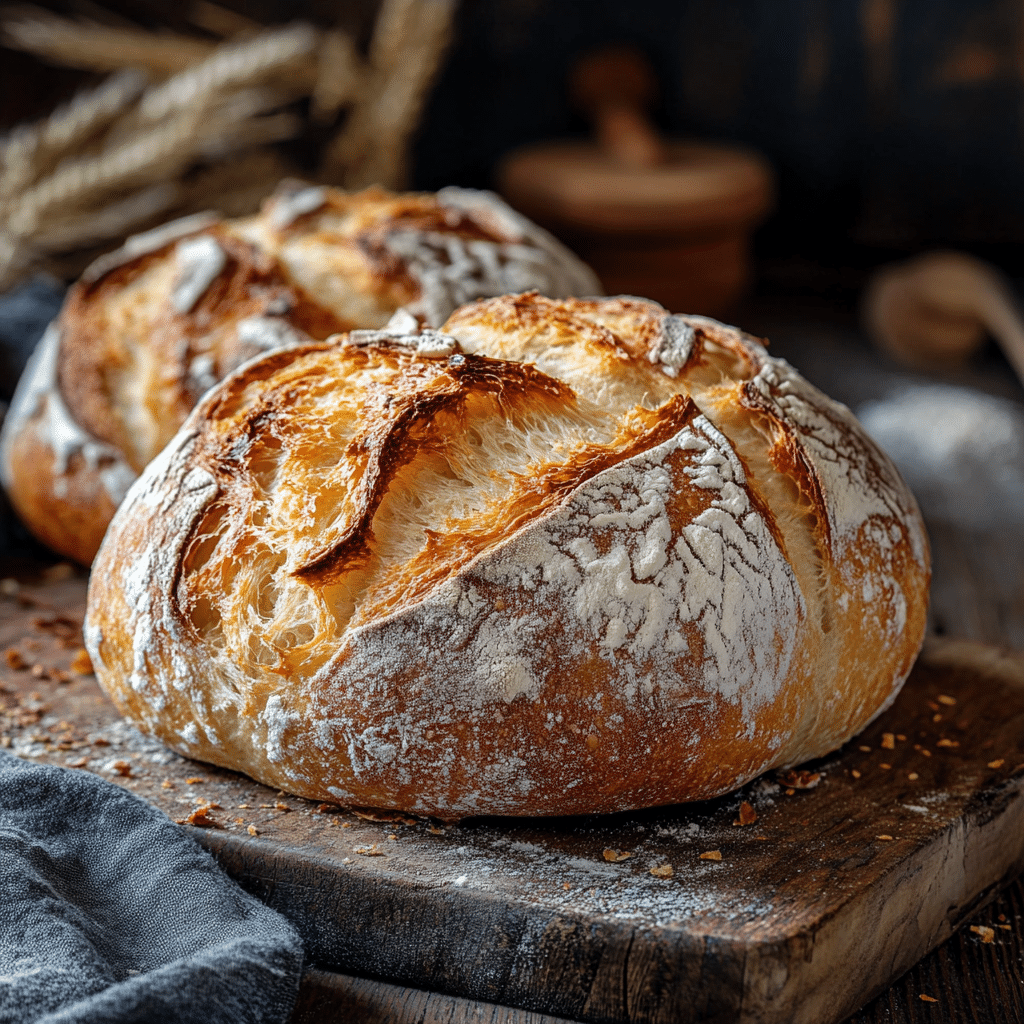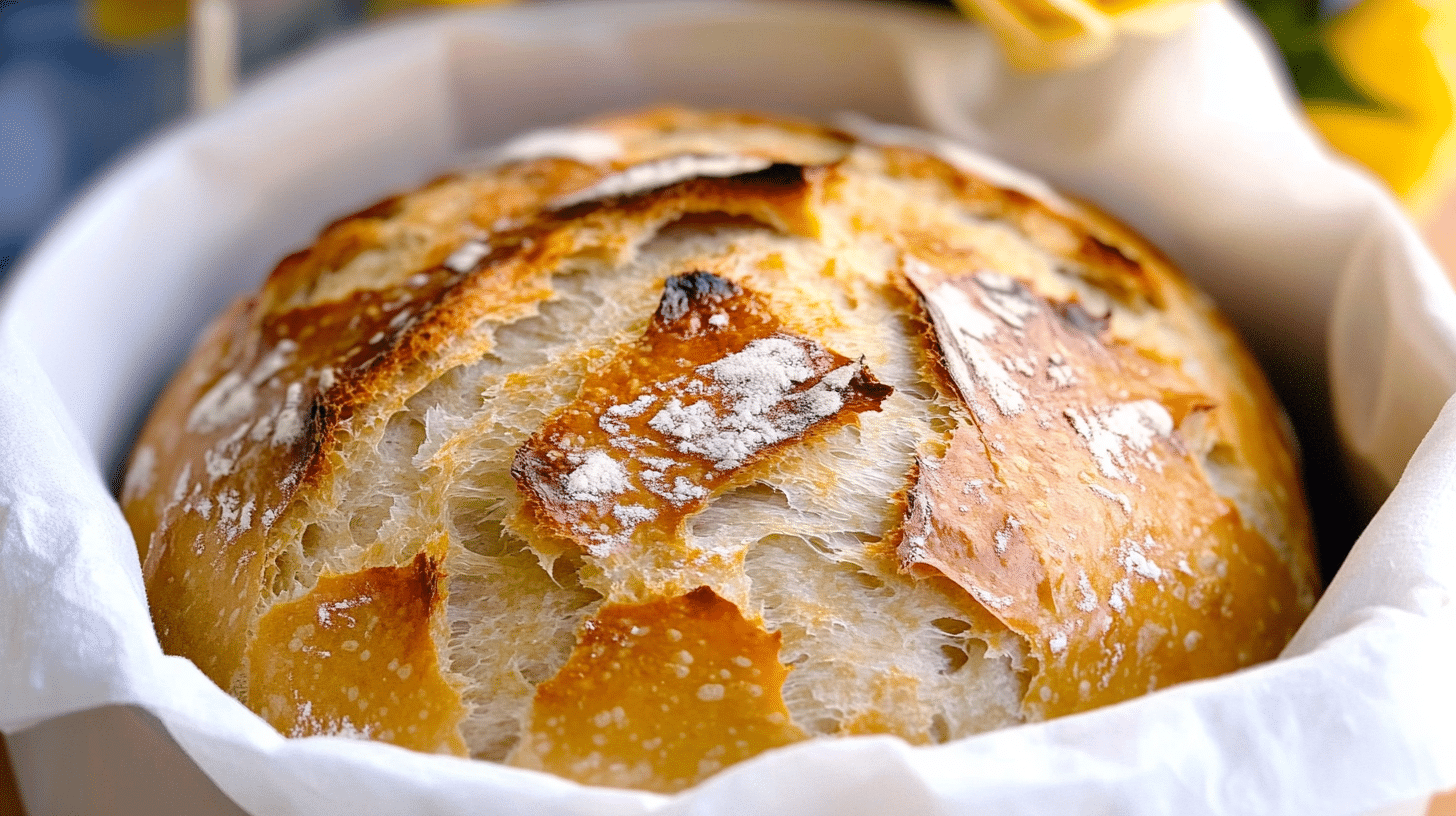This Dutch Oven No-Knead Bread is a game-changer for anyone who loves crusty, artisan-style bread but is intimidated by traditional bread baking! This recipe requires absolutely no kneading, and the Dutch oven creates a perfectly crispy crust and a soft, chewy interior. I love how simple this method is, and the results are truly amazing – you’ll get a bakery-quality loaf with minimal effort. Get ready to impress yourself (and your friends and family) with this foolproof bread recipe!
Why You’ll Love This No-Knead Bread
- No Kneading Required: The long, slow rise develops the gluten, so there’s no need for kneading.
- Crusty and Chewy: The Dutch oven creates a steam environment that results in a beautifully crusty exterior and a soft, chewy interior.
- Easy to Make: This recipe uses simple ingredients and straightforward instructions.
- Minimal Effort: Most of the time is hands-off, letting the dough rise and the oven do the work.
- Artisan-Quality: You’ll get a bakery-quality loaf of bread at home.

Ingredients for Dutch Oven No-Knead Bread
Here’s what you’ll need to make this amazing bread. The full list with measurements is in the recipe card below.
Main Ingredients
- Warm water (Liquid)
- Yeast (active dry, instant, or quick rise) (Leavening Agent)
- Fine grain salt (preferably NOT iodized) (Seasoning)
- All-purpose flour or bread flour (plus more for dusting) (Dry Ingredient) Specific brand mentioned in original recipe notes
(Note: the full ingredients list, including measurements, is provided in the recipe card directly below.)
Variations
I love this Dutch Oven No-Knead Bread as is, but here are a few ideas for variations:
- Add Herbs: Stir in some chopped fresh rosemary, thyme, or other herbs to the dough.
- Garlic and Cheese: Add some roasted garlic and grated Parmesan cheese to the dough.
- Olives and Herbs: Add some chopped Kalamata olives and herbs de Provence to the dough.
- Whole Wheat: Substitute some whole wheat flour for a portion of the all-purpose flour.
- Seeds: Add some seeds

How to Make Dutch Oven No-Knead Bread
Let me show you how incredibly easy it is to make this Dutch Oven No-Knead Bread:
Mix Ingredients
- In a large bowl (or container), I mix together the warm water (about 100 degrees F / 38°C), yeast, and salt until the yeast and salt are fully or almost dissolved. I like using a whisk for this.
- I add the flour to the bowl all at once and stir together until a sticky dough forms. I don’t worry about mixing it too much; I just make sure everything is uniformly wet. It will be messy and sticky. I can scrape what’s left on the spoon with a silicone spatula. (The texture should resemble the photo provided in the original recipe. If it seems too wet, add 1-2 tablespoons more flour at a time until it is more like the photo. If it seems too dry, do the same thing with more water).
First Rise
- I cover the bowl with a kitchen towel (or place the container lid on ajar).
- I leave it for 2-3 hours to rise in a somewhat warm place until it’s doubled in volume. (If it’s cold out, I like to preheat my oven for a few minutes, then turn it off, then place the bowl in the oven, trapping the heat inside. If your house is warm, just leave it out, or if it’s warm outside, you can place it there).
Preheat Oven and Dutch Oven
- After the two- to three-hour rise time, when the dough has about doubled, I have two options: bake, or store in the fridge.
- 30 minutes to an hour before I am ready to bake, I preheat my oven to 450 degrees F (232°C).
- I place my Dutch oven in the oven, with the lid on, while the oven is preheating. Once the oven reaches 450, I keep it preheating for another 20 minutes, so the Dutch oven gets good and hot.
Shape the Dough
- I scrape the dough into the edge of a piece of parchment paper dusted with flour.
- I make it into as much of a “loaf” shape as I can by folding the edges up on top of it (a silicone spatula works well for this).
- Then, I use the edges of the parchment paper to flip the loaf over so the floured side is on top and the loaf is in the center of the parchment paper. I don’t worry about it looking beautiful or smooth on top. My Dutch oven is an oval, so I made an oval shape. I can do a circle if the oven is round.
Score the Dough (Optional)
- Optional: I use a very sharp knife or clean razor blade to cut a few slits across the top of the loaf about ½-inch deep, across the entire top. I do this in a cross shape.
Bake
- I take out the preheated Dutch oven and take off the lid, carefully!
- I grab the parchment from the sides and place the loaf in my Dutch oven.
- I place the cover back on the Dutch oven and place it in the preheated oven on the center rack.
- I bake for 35 minutes at 450 degrees F (232°C) (40 minutes if dough was cold from the fridge).
- I remove the lid and bake for another 5-10 minutes, until a golden brown color forms – longer if necessary.
Cool and Serve
- I remove the loaf from the Dutch oven (grabbing the sides of the parchment paper works well here) and place it on a wire rack or cutting board to cool for at least 10 minutes (preferably 30 minutes – an hour, if I have time) before slicing.
Tips and Tricks for the BEST No-Knead Bread
Here are my secrets for making this bread truly exceptional:
- Warm Water: Make sure the water is warm (about 100°F/38°C) but not hot, to activate the yeast.
- Don’t Knead: The long, slow rise develops the gluten, so there’s no need to knead the dough.
- Sticky Dough is Okay: The dough will be sticky – that’s normal! Don’t add too much extra flour.
- Hot Dutch Oven: Preheating the Dutch oven with the lid on is crucial for creating a crispy crust.
- Parchment Paper: Using parchment paper makes it easy to transfer the dough to the hot Dutch oven and prevents sticking.
- Cool Before Slicing: Let the bread cool for at least 10 minutes (preferably longer) before slicing to prevent it from being gummy.
How to Serve
This Dutch Oven No-Knead Bread is delicious served:
- Warm with Butter: A classic and simple way to enjoy fresh bread.
- With Soup or Stew: Perfect for dipping into your favorite soup or stew.
- Sandwiches: Use it to make sandwiches.
- Toast: Toast slices and top with butter, jam, or your favorite spread.

Make Ahead and Storage
You can store the dough, after the first rise, in the refrigerator for up to 3 days. Baked bread can be stored at room temperature for up to 3 days or frozen for longer storage.
FAQs about Dutch Oven No-Knead Bread
- Can I use a different type of flour?
- You can use bread flour instead of all-purpose flour for a chewier loaf.
- What if I don’t have a Dutch oven?
- It is best if you cook on a Dutch Oven.
- Can I add other ingredients to the dough?
- Yes
Enjoy this incredibly easy and delicious Dutch Oven No-Knead Bread! It’s a perfect way to enjoy fresh, crusty, artisan-style bread at home.
Print
Dutch Oven No-Knead Bread
- Prep Time: 10 minutes
- Rise Time: 2 hours
- Cook Time: 40 minutes
- Total Time: 2 hours 50 minutes
- Yield: 1 loaf 1x
- Category: Bread
- Cuisine: American, Artisan Bread
Description
This Dutch Oven No-Knead Bread recipe is incredibly easy and produces a beautiful, crusty loaf with a soft, chewy interior. Minimal effort and simple ingredients yield bakery-quality results.
Ingredients
- 1 1/2 cups warm water (100-110°F / 38-43°C)
- 1 packet (2 1/4 teaspoons) active dry yeast, instant yeast, or rapid-rise yeast
- 1 1/2 teaspoons fine grain sea salt (non-iodized preferred, see notes), up to 2 teaspoons for a saltier loaf
- 3 1/4 cups (406g) all-purpose flour or bread flour, plus more for dusting (see notes)
Instructions
- Combine Water, Yeast, and Salt: In a large mixing bowl (or a large container with a lid), whisk together the warm water, yeast, and salt until the yeast and salt are mostly dissolved.
- Add Flour: Add the flour all at once to the water mixture.
- Mix Dough: Stir with a wooden spoon or spatula until a shaggy, sticky dough forms. Don’t worry about kneading; just make sure all the flour is incorporated and there are no dry spots. The dough will be messy and sticky.
- Adjust Consistency (If Needed):
- Too Wet: If the dough seems excessively wet and sticky (more like a thick batter than a dough), add more flour, 1-2 tablespoons at a time, until it reaches a shaggy, sticky consistency.
- Too Dry: If the dough seems too dry and crumbly, add more water, 1/2 tablespoon at a time, until it comes together.
- First Rise (Bulk Fermentation): Cover the bowl with a clean kitchen towel or plastic wrap (or place a lid on the container, slightly ajar). Let the dough rise in a somewhat warm place for 2-3 hours, or until it has doubled in volume. Note: If your kitchen is cold, you can preheat your oven to the lowest setting for a few minutes, then turn it off and place the covered bowl inside to rise.
- Optional Refrigeration: After the 2-3 hour rise, you have two options:
- Bake Immediately: Proceed to the next step.
- Refrigerate: For a more developed flavor, you can refrigerate the dough for up to 24 hours. Punch down the dough, reshape it gently into a ball, and place it back in the bowl (or a smaller, greased bowl). Cover tightly with plastic wrap and refrigerate. Let the dough come to room temperature for about 30-60 minutes before shaping and baking.
- Preheat Oven and Dutch Oven: 30 minutes to 1 hour before you’re ready to bake, preheat your oven to 450°F (230°C). Place your Dutch oven (with the lid on) inside the oven while it preheats. This is crucial for creating a crispy crust.
- Shape Dough: Generously dust a large piece of parchment paper with flour. Gently scrape the dough out of the bowl and onto the edge of the floured parchment paper. Shape the dough very gently into a rough loaf shape (round or oval, depending on your Dutch oven) by folding the edges of the dough up and over towards the center. Don’t worry about making it perfect; the no-knead nature of this bread means a rustic look is expected.
- Flip Dough: Use the edges of the parchment paper to carefully flip the loaf over so that the floured side is on top and the seam side is down. The loaf should now be in the center of the parchment paper.
- Score Dough (Optional): If desired, use a very sharp knife or a clean razor blade to score the top of the loaf. Make a few slashes, about 1/2-inch deep, across the entire top. This helps control the expansion of the bread during baking and creates a decorative pattern. A simple cross, a single long slash, or several parallel slashes all work well.
- Carefully Transfer to Dutch Oven: Carefully remove the very hot Dutch oven from the preheated oven. Remove the lid. Using the edges of the parchment paper as handles, carefully lower the dough (still on the parchment paper) into the hot Dutch oven.
- Bake (Covered): Place the lid back on the Dutch oven. Bake for 35 minutes at 450°F (230°C). If the dough was refrigerated, bake for 40 minutes covered.
- Bake (Uncovered): Carefully remove the lid from the Dutch oven. Continue baking, uncovered, for another 5-10 minutes, or until the crust is a deep golden brown and the internal temperature of the bread reaches 200-210°F (93-99°C). If the crust is browning too quickly, you can reduce the oven temperature slightly.
- Cool: Carefully remove the loaf from the Dutch oven (using the parchment paper as handles) and place it on a wire rack to cool completely. Cool for at least 10 minutes, and ideally for 30-60 minutes, before slicing. This allows the internal structure to set and prevents a gummy texture.
Notes
- Water Temperature: The water should be warm to the touch, but not hot (100-110°F / 38-43°C). Too hot, and it will kill the yeast; too cold, and the yeast won’t activate properly.
- Yeast: You can use active dry yeast, instant yeast, or rapid-rise yeast interchangeably in this recipe. There’s no need to proof the yeast separately.
- Salt: Non-iodized salt is preferred for bread baking, as iodine can sometimes inhibit yeast activity. However, if you only have iodized salt, it will still work.
- Flour: All-purpose flour or bread flour can be used. Bread flour will result in a slightly chewier loaf. The recipe author uses King Arthur All-Purpose flour, and other flours may yield different results.
- Rising Time: The rising time can vary depending on the temperature of your kitchen.
- Dutch Oven: A Dutch oven (4-7 quart, round or oval) is essential for creating the crispy crust and evenly baked interior. The enclosed environment traps steam, creating a similar effect to a professional bread oven.
- Parchment Paper: Parchment paper is crucial for transferring the dough to the hot Dutch oven and preventing it from sticking.
- Scoring: Scoring the loaf (making slashes on the top) is optional but recommended. It helps control the expansion of the bread during baking and creates a more aesthetically pleasing loaf.
- Cooling: Cooling the bread completely before slicing is important. This allows the internal structure to set, preventing a gummy texture.
- Storage: Store leftover bread in a paper bag at room temperature for up to 2 days. For longer storage, wrap the bread tightly in plastic wrap and then foil, and freeze for up to 2 months.

